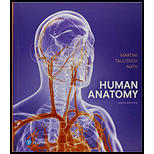
Concept explainers
To review:
Match the term elastic arteries with the most closely related descriptions given below:
deliver blood to the head
transport blood to the body’s internal organs and skeletal muscles
arteries whose smooth muscles do not contract
stationary blood clot
network of capillaries
arteries that supply a capillary network
supply blood to the upper limbs
small air sacs
supply blood to the lower limbs
collect blood from the kidneys
Introduction:
Arteries can be defined as the blood vessels that carry oxygenated blood, the only exception being the pulmonary artery. The body consists of three major types of arteries. These main arteries are muscular arteries, small arterioles, and elastic arteries. These arteries vary in thickness and diameter.
Explanation of Solution
Elastic arteries are large vessels, which are having the luminal diameter of up to 2.5 cm. They perform the function of transport of blood away from the heart. The intima layer of this artery is thick and is made up of endothelial cells, below which lies the basal lamina, which consists of elastic connective tissue and collagen fibers.
The elastic artery walls are tough due to the presence of more elastic fibers and less smooth muscles, making them tolerant of the changes in pressure during the cardiac cycle. During local or sympathetic stimulation, these smooth muscles do not contract at all.
Therefore, it can be concluded that the term elastic arteries can be correctly matched with option (c) arteries whose smooth muscles do not contract.
Want to see more full solutions like this?
Chapter 22 Solutions
Human Anatomy (9th Edition)
- (a) Name the type of blood vessel labelled (i) C. (ii) D. (b) In which direction does blood in vessel A travel? (c) Which of the four blood vessels contains the most oxygen? (d) What happens to the amount of oxygen in the blood as it passes through the body organs? (e) What is the chamber of the heart labelled X? ·arrow_forwardThe great saphenous vein drains which of the following regions of the body? (A) skin of the lateral leg (B) skin of the medial ankle (C) skin of the lateral ankle (D) A and C (incorrect) (E) B and Carrow_forwardThe two arteries formed by the division of the brachioce- phalic trunk are the (a) aorta and internal carotid. (b) axillary and brachial. (c) external and internal carotid. (d) common carotid and subclavian.arrow_forward
- The two-way exchange of substances between blood and body cells occurs only through (a) arterioles. (b) capillaries. (c) venules. (d) a, b, and c are correct.arrow_forwardWhich of the following vessels is bilaterally symmetrical (that is, has an identical member of a pair on either side of the body)? (a) internal carotid artery, (b) brachiocephalic trunk, (c) azygos vein, (d) superior mesenteric vein.arrow_forwardThe two arteries formed by the division of the brachiocephalic trunk are the(a) aorta and internal carotid. (b) axillary and brachial. (c) external and internal carotid. (d) common carotid and subclavian.arrow_forward
- Compared with the interstitial fluid that bathes active muscle cells, blood reaching these cells in arteries has a(A) lower osmotic pressure.(B) higher PO2.(C) lower pH.(D) higher PCO2.(E) greater bicarbonate concentration.arrow_forwardCompared with the interstitial fluid that bathes active musclecells, blood reaching these cells in arterioles has a(A) higher PO2.(B) higher PCO2.(C) greater bicarbonate concentration.(D) lower pH.arrow_forwardBlood flow through the capillaries is steady despite the rhythmic pumping action of the heart because of the (a) elasticity of the large arteries only, (b) elasticity of all the arteries, (c) ligamentum arteriosum, (d) venous valves.arrow_forward
- Identify this blood vessel. (A) capillary (B) arteriole (C) elastic artery (D) muscular arteryarrow_forwardThe obturator vein drains deoxygenated blood from the hip joint and medial thigh into the (A) external iliac vein (B) femoral vein (incorrect) (C) popliteal vein (D) internal iliac vein (E) inferior vena cavaarrow_forwardThe blood vessels that collect blood from all tissues and organs and return it to the heart are the, (a) veins. (b) arteries. (c) capillaries. (d) arterioles.arrow_forward
 Human Anatomy & Physiology (11th Edition)BiologyISBN:9780134580999Author:Elaine N. Marieb, Katja N. HoehnPublisher:PEARSON
Human Anatomy & Physiology (11th Edition)BiologyISBN:9780134580999Author:Elaine N. Marieb, Katja N. HoehnPublisher:PEARSON Biology 2eBiologyISBN:9781947172517Author:Matthew Douglas, Jung Choi, Mary Ann ClarkPublisher:OpenStax
Biology 2eBiologyISBN:9781947172517Author:Matthew Douglas, Jung Choi, Mary Ann ClarkPublisher:OpenStax Anatomy & PhysiologyBiologyISBN:9781259398629Author:McKinley, Michael P., O'loughlin, Valerie Dean, Bidle, Theresa StouterPublisher:Mcgraw Hill Education,
Anatomy & PhysiologyBiologyISBN:9781259398629Author:McKinley, Michael P., O'loughlin, Valerie Dean, Bidle, Theresa StouterPublisher:Mcgraw Hill Education, Molecular Biology of the Cell (Sixth Edition)BiologyISBN:9780815344322Author:Bruce Alberts, Alexander D. Johnson, Julian Lewis, David Morgan, Martin Raff, Keith Roberts, Peter WalterPublisher:W. W. Norton & Company
Molecular Biology of the Cell (Sixth Edition)BiologyISBN:9780815344322Author:Bruce Alberts, Alexander D. Johnson, Julian Lewis, David Morgan, Martin Raff, Keith Roberts, Peter WalterPublisher:W. W. Norton & Company Laboratory Manual For Human Anatomy & PhysiologyBiologyISBN:9781260159363Author:Martin, Terry R., Prentice-craver, CynthiaPublisher:McGraw-Hill Publishing Co.
Laboratory Manual For Human Anatomy & PhysiologyBiologyISBN:9781260159363Author:Martin, Terry R., Prentice-craver, CynthiaPublisher:McGraw-Hill Publishing Co. Inquiry Into Life (16th Edition)BiologyISBN:9781260231700Author:Sylvia S. Mader, Michael WindelspechtPublisher:McGraw Hill Education
Inquiry Into Life (16th Edition)BiologyISBN:9781260231700Author:Sylvia S. Mader, Michael WindelspechtPublisher:McGraw Hill Education





